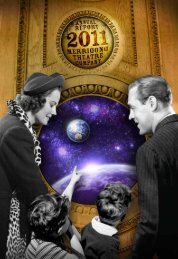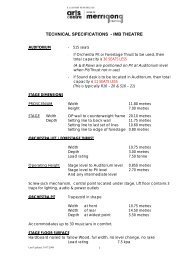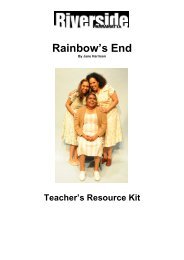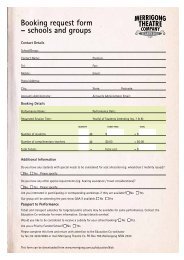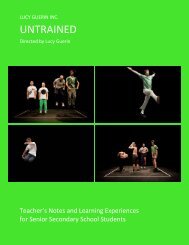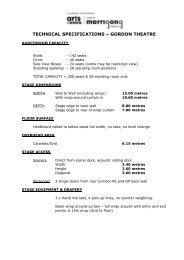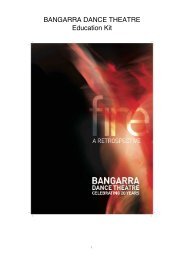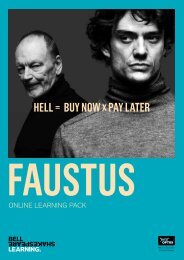Hickory Dickory Dock
Hickory Dickory Dock - Internode Hosting for patchtheatre.org.au
Hickory Dickory Dock - Internode Hosting for patchtheatre.org.au
- No tags were found...
You also want an ePaper? Increase the reach of your titles
YUMPU automatically turns print PDFs into web optimized ePapers that Google loves.
0<br />
A Play Package<br />
for<br />
Patch Theatre Company’s<br />
production of<br />
<strong>Hickory</strong> <strong>Dickory</strong> <strong>Dock</strong>
CONTENTS<br />
Contents - Page 1<br />
Introduction - Page 2<br />
Objectives<br />
Time<br />
Two Realities<br />
A Personal Thought<br />
Pilawuk<br />
Seconds: Page 4<br />
Embodying Seconds<br />
Seconds Sequence<br />
Henry’s Heart beat<br />
Minutes: Page 5<br />
One minute Song<br />
Resting Heart-Rate<br />
Active Heart-Rate<br />
Counting Game<br />
Balloon Olympics: Page 6<br />
Sticky Balloons<br />
Balloon Twirling<br />
Balloon Bouncing<br />
Balloon Tennis<br />
Balloon Passing<br />
Balloon Bouncing Circle Game<br />
Game Creation #1<br />
Game creation #2<br />
How Long: Page 9<br />
Cup Challenge<br />
Cup Game<br />
Paper Walking<br />
Rocket Balloons<br />
Balloon Rocket Race<br />
Balloon Powered Helicopters<br />
Balloon Powered Rocket Cars<br />
Balloon Bust<br />
County to Twenty<br />
What and When: Page 13<br />
Lists<br />
Time and Lists<br />
Variations<br />
Book Time: Page 15<br />
Appendixes: Page 17<br />
Appendix 1 – Here and Now (song lyrics)<br />
Appendix 2 – One Minute Song (song lyrics)<br />
Appendix 3 – The Story of Henry’s Heart<br />
Appendix 4 – Twenty Minute Song (song lyrics)<br />
Credits/Contacts: Page 22<br />
Full Play Package details with downloads<br />
are available online:<br />
http://www.patchtheatre.org.au/hdda.htm<br />
1
INTRODUCTION<br />
Objectives<br />
Our <strong>Hickory</strong> <strong>Dickory</strong> <strong>Dock</strong> Play Package objectives are:<br />
• For children to be engaged in meaningful interactions with other children<br />
requiring thinking, sharing, negotiating, empathising, hypothesising and testing<br />
in the context of creative and playful explorations around the theme of time.<br />
• For our activities to be a springboard for broader, open-ended explorations<br />
that, with support and encouragement from teachers, will allow children to<br />
unravel some of the mysteries and magic of our temporal existence.<br />
Time<br />
We invite you to turn your class into a time capsule and your children into time<br />
travelers dedicated to exploring the wonders of time in both creative and practical<br />
ways.<br />
At the heart of our project is a celebration of the adventure of learning and the<br />
encouragement of both logical and magical thinking by children. The richness of<br />
that adventure for children is a measure of how inspiring and supportive we as<br />
educators can be.<br />
For every dilemma Henry Horatio Richard O’<strong>Dock</strong>erty confronts in <strong>Hickory</strong><br />
<strong>Dickory</strong> <strong>Dock</strong>, there is a supportive adult – be it teacher, parent or grandparent<br />
encouraging exploration, provoking responses, asking questions, seeking<br />
meaning, beckoning adventure. Our challenge is to have children take a journey<br />
akin to Henry's.<br />
Two Realities<br />
Children's lives have two realities. One is the temporal, pragmatic, moment by<br />
moment reality, where they are driven by activity, squeezed by demands, guided<br />
by schedules, dictated to by time-lines and shunted to and fro by the day-to-day<br />
demands of their lives… a place where time matters. The other is their world of<br />
dreams and imaginings. This is their place of play and ideas; of art and<br />
creativity... the place of magic and fantasy... a place where time dissolves.<br />
Many children learn and develop most effectively in environments where they<br />
are encouraged to function like artists making art. In these artistic environments<br />
they are engaged in meaningful and open-ended explorations of themes or ideas<br />
within a framework, whose scaffolding is supported by teacher initiated<br />
activities. This is an environment where both logical and creative thinking are<br />
equally valued; where the temporal and imaginative realms of a child co-exist.<br />
This is the place from which our play package for <strong>Hickory</strong> <strong>Dickory</strong> <strong>Dock</strong> has<br />
evolved.<br />
2
“Creativity represents the miraculous coming together of the uninhibited energy<br />
of the child with its apparent opposite and enemy – the sense of order imposed on<br />
the disciplined adult intelligence.” Norman Podhoretz<br />
A Personal Thought<br />
After working on this project and thinking about time removed, I’ve come to<br />
realise how my own anxieties about deadlines and time-lines has caused me to<br />
lose, on many occasions, the joy of what I am doing in the present.<br />
We’ve written a little song to remind us to love and enjoy the “here and now."<br />
(Download song MP3 or use CD track 1, song lyrics in appendix 1) The lyrics<br />
are as follows:<br />
Here and Now<br />
Right here<br />
Right here and now<br />
Discover the wonder<br />
These moments allow<br />
Right here<br />
Right here and now<br />
Discover the wonder<br />
These moments allow<br />
Pilawuk<br />
Pilawuk provides perspective on how children could deal with the<br />
disappointment of not being the ‘chosen’ student for the activities in this play<br />
package and at the performance of <strong>Hickory</strong> <strong>Dickory</strong> <strong>Dock</strong> in the following<br />
passage:<br />
“In my language, Ngangiwumerri, we teach children to think of others and make<br />
others happy. We learn by 'doing' and by 'watching/observing'. Sometimes in life<br />
we want to 'do' fun things all the time. To grow up into a good person we also<br />
need to 'watch/observe' others having fun even if we are busting to 'do' the fun<br />
things. In my language when you are not chosen to 'do' the fun thing/activity and<br />
you have to 'watch/observe' we say 'nyinyi ta nginni' which means 'I'm happy for<br />
you!' Say this ('nyinyi ta nginni' and the person's name) in your head and SMILE.<br />
Keep smiling until all the sadness in your gut/tummy from not being picked has<br />
gone or until the activity has finished. Learn how to say it in your own language<br />
or other languages so that every time you are not chosen you can look forward to<br />
saying 'I'm happy for you…(name) in different languages.”<br />
Nyinyi ta nginni - Pronunciation:<br />
• Nyin-yi ('nyin' sound the 'n' then say 'yin' as in 'yin yang', 'yi' as in the 'ye' in<br />
'year')<br />
• ta (the 'a' is an 'u' sound as in 'up')<br />
• ngin-ni ('ng' as in 'sing', 'in' as in the English word 'in' & 'ni' as in knee')<br />
3
SECONDS<br />
This section explores the notion of seconds. It consists of 3 suggested activities:<br />
Embodying Seconds, Seconds Sequence, Henry’s Heartbeat.<br />
1. Embodying Seconds<br />
a) Tell the children that a second is the time it takes to jump in the air, or to wave<br />
or to turnaround or to wink.<br />
b) Ask the children to think of other things that take about one second - there are<br />
lots. Make a list, e.g. a skip, a clap, a kiss, a yawn, a slap, a smile, a breath, a<br />
step, a scratch, a knock, a click, a bounce, a flick, fold arms, a puff, a sigh, a yelp,<br />
a hand shake, a nod, a tongue poke, a nudge, a grab, a pop, a drip, a bark.<br />
c) Going around the circle, ask each child to choose one action that takes about a<br />
second to do.<br />
d) Then go around the circle with each child doing their action in turn.<br />
e) Ask the children how many seconds it should take to get around the circle. If<br />
each of their actions takes one second, how many seconds will 15 actions take?<br />
2. Seconds Sequence<br />
a) Ask each child to choose 3 one-second actions and get them to put the 3<br />
actions together in a 3 second sequence. The teacher could demonstrate. Children<br />
could draw their choices out of a hat, e.g. a smile, a skip, and a turn.<br />
b) When children have had time to practice their sequence get them to loop the<br />
sequence - repeat it over and over.<br />
c) Tell the children that you will play a song called the One Minute Song<br />
(download MP3 or use CD track number 1, lyrics in appendix 2) that will last<br />
exactly sixty seconds. Ask them to do their sequence as a dance for the length of<br />
the song.<br />
3. Henry’s Heartbeat<br />
a) Read the story of Henry's Heart to the children (download story as a PDF or<br />
PowerPoint, text in appendix 3).<br />
b) The story can be shown on computer or printed out and read.<br />
c) Explain to the children that often when people say, wait a second they don’t<br />
really mean wait one second like Henry thought they did - they really mean wait<br />
4
until I’m ready, I won’t be long.<br />
d) Ask the children if they have any stories about being asked to wait a minute or<br />
wait a second or a moment?<br />
e) Read the story again.<br />
MINUTES<br />
This section explores the notion of minutes. It consists of 4 suggested activities:<br />
One Minute Song, Resting Heart Rate, Active Heart Rate, and Counting Game.<br />
1. One Minute Song (download song MP3 or use CD track 1)<br />
a) Ask the children to lie down on the floor.<br />
b) Tell them you are going to play a song that lasts exactly one minute.<br />
c) Ask them to listen to the words - there are exactly sixty words in the song (see<br />
appendix 2).<br />
d) Encourage the children to learn the song and sing along with it – as it is used<br />
in the activities to follow.<br />
2. Resting Heart-Rate<br />
a) The children are still lying on the floor from the first activity.<br />
b) Play the One Minute Song again, asking the children to count their heartbeats<br />
during the song.<br />
c) Record the number of heartbeats per minute for each child under the heading<br />
“Resting Heart Rate”.<br />
d) Go on to the next activity.<br />
3. Active Heart-Rate<br />
a) Tell the children they’re going to play air-guitar during a special one minute<br />
punk rock song called Beat the Clock! (download song MP3 or use CD track 2,<br />
lyrics in appendix).<br />
b) Encourage the children to jump up and down and use lots of energy.<br />
c) Repeat the Beat the Clock! song. Provide the children with tennis rackets to<br />
use as guitars or hairbrushes to use as microphones – call for bigger actions,<br />
more vigorous dancing, and lots of jumping up and down.<br />
d) Get the children to count their heartbeat while playing the One Minute Song.<br />
e) Record the results on the white board next to their resting pulse rate recorded<br />
earlier in beats per minute.<br />
f) Ask the children to suggest why their heartbeat got faster. Accept their ideas.<br />
4. Counting Game<br />
a) Form a circle. The person beginning the Clapping-Counting Game points to<br />
any other person in the circle and says “one” and walks to where “one” is<br />
5
standing in the circle.<br />
b) The person who has been pointed at, then in turn, points at another person as<br />
they say “two” and walks to where that person is standing in the circle... and so<br />
on.<br />
c) The One Minute Song is then played and the children see how many counts<br />
they can make in one minute. They establish a record number of counts per<br />
minute.<br />
d) The record is there to be beaten!<br />
BALLOON OLYMPICS<br />
This section suggests activities that use balloons to highlight the theme of time.<br />
The 8 activities include: Sticky Balloons, Balloon Twirling, Balloon Tennis,<br />
Balloon Passing, Balloon Bouncing Circle Game, Game creation #1, Game<br />
Creation #2.<br />
1. Sticky Balloons<br />
a) Have fifteen small, round balloons blown up and placed on the floor.<br />
b) A child stands in the middle of the circle.<br />
c) The teacher rubs the balloon on their hair and sticks it to the child using<br />
electrostatic charge.<br />
d) See how many balloons can be stuck to the child in one minute.<br />
e) Make small teams of up to 4 children and play the One Minute Song to time<br />
the game.<br />
f) Create a record and see if other teams can beat it. Try it on different days - the<br />
results achieved can differ markedly according to the humidity of the weather.<br />
Dry days are best!<br />
2. Balloon Twirling<br />
a) Prepare blown-up balloons on strings about 40 cm long.<br />
b) Demonstrate how to twirl the balloon around your head.<br />
c) Get the children to twirl their balloons 10 times while counting aloud.<br />
c) Ask the children to count how may times they can twirl the balloon around<br />
their head in one minute, while you play the One Minute Song.<br />
d) Variation - how slowly can you twirl the balloon?<br />
6
3. Balloon Bouncing<br />
a) Groups of 6 children are challenged to keep 6 balloons in the air for one<br />
minute using the One Minute Song.<br />
b) Variations - using only one hand - using no hands - using your feet.<br />
c) More variations - 8 balloons or 10 balloons or 12 balloons with 6 people.<br />
4. Balloon Tennis<br />
a) In teams of two, children are asked to tap the balloon from person to person<br />
counting their taps.<br />
b) They are asked to see how many times they can tap the balloon without the<br />
balloon touching the ground.<br />
c) Count how many times you can tap the balloon in a minute. Tell the children<br />
it's not a race.<br />
d) Variation - no hands e.g. use your elbow, feet, heads etc.<br />
5. Balloon Passing<br />
a) Pairs are given two pieces of A5 paper each and a 15 cm balloon.<br />
b) The paper is placed on the ground and the children place their feet on the<br />
paper opposite each other.<br />
c) The balloon is thrown by one and caught by the other and then returned.<br />
d) Neither pair is allowed to move their feet.<br />
e) Once the skill has been achieved - pairs count how many throw-catch passes<br />
they can make successfully in a minute without moving their feet.<br />
f) Variation - tap tennis.<br />
7
6. Balloon Bouncing Circle Game<br />
a) Form a circle. An inflated balloon is tapped around the circle from one person<br />
to the next until it completes one circuit. Everyone in the circle must tap the<br />
balloon in turn.<br />
b) Repeat the exercise, this time the whole group counting each time the balloon<br />
is tapped ... 1, 2, 3, and so on.<br />
c) When the group can do this adequately, present the group with the following<br />
challenge: What is the smallest number of taps the circle can achieve in one<br />
minute? (The balloon will need to be kept in the air for a maximum amount of<br />
time between taps for them to be successful at this task.)<br />
7. Game Creation #1<br />
a) Ask children in pairs to make up a game using balloons and/or straws.<br />
b) After working out what the game will be, the children are asked to teach the<br />
game to another pair of children.<br />
c) They should be able to explain:<br />
• What things are needed for the game to be played<br />
• What the aim of the game is<br />
• What the rules of the game are<br />
8
8. Game Creation #2<br />
a) Ask the children to make up a one minute game, using balloons, straws and the<br />
One Minute Song.<br />
HOW LONG<br />
This section suggests activities that explore the notion of ‘how long’. The 9<br />
activities include: Cup Challenge, Cup Game, Paper Walking, Rocket Balloons,<br />
Balloon Rocket Race, Balloon Powered Helicopters, Balloon Powered Rocket<br />
Cars, Balloon Bust, Counting to Twenty.<br />
1. Cup Challenge<br />
a) Ask your children to solve the following problem: How can you move a plastic<br />
cup from one place to another using only a balloon?<br />
b) Use a stopwatch to see how long they take to solve the problem.<br />
c) Provide small groups with a balloon and a plastic cup and start the stopwatch.<br />
d) When the problem is solved tell them how long it took.<br />
(The solution is: place the deflated balloon inside the cup and blow some air into<br />
it, so the inflated balloon fills up the cup…move the cup to where you want to<br />
place it and release the cup by deflating the balloon. Note: children may come up<br />
with other creative possibilities)<br />
2. Cup Game<br />
a) The challenge is to see how long it takes, as a relay team, to carry the cup with<br />
the balloon from one side to another and back again until every member has had<br />
a turn.<br />
b) Record the time it takes the relay team to complete the task.<br />
c) Try to beat the time using the same team.<br />
9
3. Paper Walking<br />
a) Pairs are given a balloon and three pieces of A5 paper. Two lines are marked<br />
on the ground - a starting line and a finishing line.<br />
b) One member of the team places the paper pieces on the ground to make<br />
stepping stones for the other team member, who carries the balloon from start to<br />
finish.<br />
c) One team member carries the balloon and the other the paper on the way over<br />
and then they swap on the return journey.<br />
d) Their journey is timed and the time recorded.<br />
e) The paper walk is done by the same team each day for a week and<br />
improvement or otherwise noted (teamwork should improve the outcome).<br />
f) Variations - balance balloon on one hand, keep the balloon in the air by<br />
tapping it.<br />
4. Rocket Balloons (These are best played outside in a park OR on an oval)<br />
a) Buy a couple of packets of Rabbit Rocket Balloon from Peter Van the Party<br />
Man ($4 for 12).<br />
b) Pump up a rocket balloon (buy a $5 balloon pump).<br />
c) Use a stop watch to see how long the balloon stays in the air.<br />
d) Ask the children to fire off their rocket balloon and then try to catch it when it<br />
comes down.<br />
5. Balloon Rocket Race<br />
a) In a circle play the Clapping-Counting Game – e.g. a child claps their hands<br />
towards another child in the circle and calls "one".<br />
10
) The child receiving the clap, then claps towards another child in the circle as<br />
they call "two"<br />
c) The game continues...<br />
d) Once all the children understand the Clapping-Counting Game, a child in the<br />
circle is given a rocket balloon.<br />
e) The children begin the Clapping-Counting Game as the child releases the<br />
rocket balloon.<br />
(f.) The challenge is to see how many claps the circle can achieve before the<br />
rocket balloon falls to the ground.<br />
6. Balloon Powered Helicopters (out door activity)<br />
a) Demonstrate the balloon helicopter (a balloon with a small propeller attached<br />
to it – available at Peter Vans the Party Man for $1) to pairs of children and get<br />
them to play with them until they can make them fly.<br />
b) Children use a stopwatch to see how long the balloon helicopter can stay in the<br />
air.<br />
c) Children establish a record and then try to beat it.<br />
d) Ask children to find out what will stay up longer – a rocket balloon or a<br />
balloon helicopter?<br />
e) Children play the Clapping-Counting Game to see what number the team can<br />
get up to whilst the balloon helicopter is in the air.<br />
7. Balloon Powered Rocket Cars<br />
a) Buy and assemble a pair of balloon powered rocket cars for children to play<br />
with.<br />
b) Have them race the cars against each other over a 6-metre distance.<br />
c) Time individual cars over the 6-metre distance with a stop watch.<br />
d) Then race the cars against each other.<br />
(Buy the car at Windmill Toys or National Geographic Shop - it is called the<br />
Balloon Powered Cosmic Jet Jet Racer a 4M KidzLabs Fun Science Product)<br />
8. Balloon Bust<br />
a) Place some balloons in the centre of a circle.<br />
b) Tell the children you will time them to see how long it takes to bust a balloon<br />
11
y sitting on it.<br />
c) Who is the fastest balloon buster?<br />
9. Counting To Twenty<br />
a) The basis of this game is "can you count to 20 faster than it takes to...?"<br />
b) Children learn the Counting to Twenty song together (download song MP3 or<br />
use CD track 5, lyrics in appendix ?).<br />
c) Once the song is learnt, undertake the following challenges:<br />
• Can you count to twenty with the song faster than it takes for a 3 foot<br />
balloon to deflate?<br />
• Can one group count to twenty with the song faster than another group of<br />
five can stick 20 small balloons to the wall using electrostatic attraction?<br />
• Can one group count to twenty with the song faster than another group<br />
can sing the nursery rhyme - <strong>Hickory</strong> <strong>Dickory</strong> <strong>Dock</strong>?<br />
d) Ask the children to make up their own "counting to twenty" game.<br />
12
WHAT AND WHEN<br />
This section suggests activities that explore the notion of ‘what and when’. These<br />
3 activities are: Lists, Time and Lists, Variations.<br />
1. Lists<br />
a) Ask the children to help you make a list of all the things they have to do in the<br />
morning before they leave for school e.g. get up, go to the toilet etc. Compare<br />
two children's morning routines to demonstrate differences.<br />
b) Then tell the children, Henry's story:<br />
“When Henry went to stay at his gran’s overnight, she told him they would have<br />
to catch the train to school at 8:10am the next morning. So Henry and his gran<br />
made a list of things he had to do so they could get to the train on time.”<br />
c) Show the picture list to the children (shown below or download PowerPoint).<br />
Recite the list together.<br />
!Wake up<br />
!Go to the toilet !Get dressed<br />
!Eat breakfast<br />
!Brush your teeth !Pack your school bag<br />
!Drive to the station !Get your ticket for the train !Catch the train to school<br />
d) Clap your hands and chant the list together: wake up, go to the toilet, get<br />
dressed, eat your breakfast, clean your teeth, pack your school bag, drive to the<br />
station, get your ticket for the train, and catch the train to school.<br />
e) Talk about Henry's list.<br />
2. Time and Lists<br />
a) Tell the story of what Henry and his gran did next:<br />
“When Henry and Gran had made their list, Gran put times next to each of the<br />
things they had to do, so they could get to the train station at 8:05am to buy<br />
13
tickets for the train.” Discuss the list and the times with your children (a table of<br />
the times and pictures are provided below)<br />
Action<br />
Time<br />
Wake up<br />
7 o’clock<br />
Go to the toilet 7:10<br />
Get dressed 7:20<br />
Eat your breakfast 7:30<br />
Clean your teath 7:40<br />
Pack your school bag 7:50<br />
Drive to the station<br />
8 o’clock<br />
Buy tickets for the train 8:05<br />
Catch the train to school 8:10<br />
!Wake up<br />
!Go to the toilet !Get dressed<br />
!Eat your breakfast !Brush your teeth !Pack your school bag<br />
!Drive to the station !Buy tickets for the train !Catch the train to school<br />
3. Variations<br />
a) We invite teachers to design their own lessons around our little scenario. Older<br />
children could look at train schedules.<br />
14
BOOK TIME<br />
There's a host of illustrated children's books that provide wonderful insights into<br />
the impact of time.<br />
The Giving Tree by Shel Silverstein Published by HarperCollins IBSN 0-06-<br />
025665-6 A powerful parable about time and giving. Great for looking at the<br />
span of a life time and the changes that brings.<br />
Belonging by Jeannie Baker Published by Walker Books ISBN 0-7445-9227-5<br />
A wordless picture book that presents the changes time brings to the view<br />
through a window.<br />
Tick-Tock by James Dunbar Published by Franklin Watts ISBN 0-7496-5688-3<br />
A practical look at time and its measurement.<br />
On the Day You Were Born by Debra Frasier Published by Harcourt, Inc. IBSN<br />
0-15-257995-8 A beautiful picture book evoking the sense of the universal<br />
wonder and significance of a new birth.<br />
Sophie by Mem Fox Illustrated by Aminah Brenda Lynn Robinson Published by<br />
Voyager Books ISBN O-15-201598-1 As Sophie grows bigger her Grandfather<br />
gets smaller and when he passes away a new baby is born in the family<br />
Wilfred Gordon McDonald Partridge by Mem Fox Illustrated by Julie Vivas<br />
Published by Omnibus Books ISBN 0 949641 16 2 A child helps an old lady<br />
rekindle her memories.<br />
Seven More Sleeps by Margaret Wild and Donna Rawlins Published by<br />
Working Title Press ISBN 1-876288-60-4 A delightful book about waiting for a<br />
birthday.<br />
Samsara Dog by Helen Manos, illustrated by Julie Vivas. ISBN 1-876288 62 0<br />
A beautiful and moving story about a dog and his many lives –based on the<br />
Buddist concepts of Samsara and Nirvana. Ideal for inspiring thoughts about the<br />
big picture of time and our place in it.<br />
What Time Is It - Mr Crocodile? by Judy Sierra Illustrated by Doug Cushman.<br />
Published by Koala Books<br />
ISBN 0-86-461-687-2 A fun look at the daily schedule of a crocodile and some<br />
pesky monkeys.<br />
Baloney by Jon Scieszka and Lane Smith - published by Puffin. ISBN 0-670-<br />
89248-3 Henry P Baloney has an amazing excuse for being late to school.<br />
Hilarious and imaginative.<br />
A Second is a Hiccup by Hazel Hutchins and Kady MacDonald Denton -<br />
published by Scholastic - ISBN 0-439-94903-3 - A rhyming book on time and<br />
how long a second, minute, hour, day, week, month and year and beyond, is.<br />
15
You'll Soon Grow into Them Titch by Pat Hutchins - published by<br />
Greenwillow Books - ISBN 0-688-11507-1 A warmly, humorous story about<br />
Tich, growing-up and hand-me-down clothes.<br />
Waiting for Mummy byTae-Jun Lee and Dong-Sung Kim ISBN 0-9585571-4-4<br />
Beautifully illustrated poignant story about a boy waiting at a bus stop for his<br />
mum.<br />
Meanwhile by Jules Feiffer Published by HarperCollins, ISBN 97-70129 An<br />
hilarious action-packed adventure showing how Raymonds resourceful<br />
imagination allows him to deal with the demands of time.<br />
All By Myself by Aliki ISBN0-06-028929-5 We share the routine of a child's<br />
day and the things the child can do without assistance beginning in bed the<br />
morning and ending in bed at night.<br />
16
Appendix 1<br />
Here and Now (Song lyrics)<br />
Right here<br />
Right here and now<br />
Discover the wonder<br />
These moments allow<br />
Right here<br />
Right here and now<br />
Discover the wonder<br />
These moments allow<br />
Appendix 2<br />
One Minute Song<br />
Sixty seconds in a minute<br />
It takes sixty beats to fill it<br />
Sixty hiccups, sixty hops<br />
Sixty ticks or sixty tocks<br />
Sixty skips or sixty claps<br />
Sixty drips from leaky taps<br />
Sixty spins or sixty turns<br />
Sixty blows in a balloon<br />
Or sixty words sung in this song<br />
Tell us that this minute’s done<br />
Sixty seconds been... and .... gone.<br />
Appendix 3<br />
The Story of Henry’s Heart<br />
Page 1<br />
APPENDIXES<br />
Henry Horatio Richard O’<strong>Dock</strong>erty loved going to school.<br />
Page 2<br />
Mrs Tunbridge Wells was Henry’s teacher and it was the end of a busy day.<br />
“Time to pack up”, said Mrs Tunbridge Wells<br />
Page 3<br />
“Mrs Wells?” said Henry.<br />
17
“Just a second Henry”, said Mrs Wells, who was getting a bandaid out to fix the<br />
scratch on Sophie Hodge’s knee.<br />
Page 4<br />
“Just a second?” Henry put his hand on his chest.<br />
Henry’s dad had told him that one heartbeat is the same as one second.<br />
Page 5<br />
But Henry couldn’t find his heart.<br />
“Ahhhhh! Mrs Wells!” cried Henry. “My heart has stopped!”<br />
Page 6<br />
Mrs Well’s eyes went up into her head.<br />
“Henry, if your heart had stopped you’d be dead. Now just give me one minute to<br />
fix up Sophie here.”<br />
“One minute! But Mrs Wells, that’s 60 seconds!!”<br />
Page 7<br />
Just then, Sophie started screaming because Jason Wipple had banged her knee<br />
with a hammer to try to fix it up. “Waaaaaaahhh!”<br />
Page 8<br />
Henry tried to keep calm. “60 seconds … that’s 60 heart beats.”<br />
But Henry still couldn’t find his heart. He wondered if he was having a heart<br />
attack like his grandpa!<br />
Page 9<br />
“Mrs Wells! Mrs Wells!!”<br />
“One moment Henry please!”<br />
Sophie was still sobbing into Mrs Wells left shoulder, while Mrs Wells was<br />
trying to explain to Jason Wipple that hammers don’t fix everything.<br />
Page 10<br />
18
One moment!? No-one had told Henry about moments and Henry was quite<br />
worried about his heart.<br />
Page 11<br />
“Mrs Wells!!!”<br />
“Henry, you must learn to be patient!”<br />
“But who’s going to find my heart?”<br />
Page 12<br />
Mrs Tunbridge Wells breathed a big sign and turned to Sophie.<br />
“Sophie - would you help Henry find his heart?”<br />
“I think it’s over there somewhere,” cried Henry pointing his finger no-where in<br />
particular.<br />
Page 13<br />
Henry Horatio Richard O’<strong>Dock</strong>erty took Sophie Hodges by the hand and<br />
together they went looking for Henry’s heart.<br />
Page 14<br />
They eventually found it in Sophie’s lunch-box.<br />
It looked just like an orange – but sure enough, as Henry ate it there in his chest,<br />
Sophie could hear Henry’s heartbeat return.<br />
Page 15<br />
“Sophie, I think your mum’s here to pick you up?”<br />
“Just a minute please Mrs Wells,” said Henry in his best teacher’s voice.<br />
“We are busy at the moment listening to my heart. Sophie’s mum will just have to<br />
wait.”<br />
Page 16<br />
And while she waited, Henry and Sophie counted to 60.<br />
19
Appendix 4<br />
Can Ya Beat The Clock? (Song lyrics)<br />
Can ya feel the tick?<br />
Can ya feel the tock?<br />
Can ya feel the beat?<br />
Can ya beat the clock?<br />
CHORUS<br />
Can ya beat the clock?<br />
Can ya beat the clock?<br />
Can ya beat it? Can ya, can ya can ya?<br />
Can ya beat the clock?<br />
Can ya beat the clock?<br />
Can ya beat it? Can ya, can ya can ya?<br />
Can ya feel the riff?<br />
Can ya feel the rock?<br />
Can ya feel the beat?<br />
REPEAT CHORUS<br />
20
CREDITS<br />
The development of this play package has been generously supported by ArtsSA's<br />
Health Promotions Community Arts Fund. The research for the package took<br />
place alongside the development of the performance itself and each process<br />
provided inspiration for the other.<br />
We thank the Early Childhood Education Team who generously supported the<br />
creation of the play package.<br />
<strong>Hickory</strong> <strong>Dickory</strong> <strong>Dock</strong> Play - Package Development Group:<br />
Elspeth Harley - Curriculum Policy Officer, Early Years DECS<br />
Nicole Hentschke - Enfield Folland Park Kindergarten<br />
Lesley Hooper - Flagstaff Oval Kindergarten<br />
Sue Caldicott - Flagstaff Oval Kindergarten<br />
Damien Vahlis – Mercedes College<br />
Amanda Nichols – Lady Gowrie Child Centre<br />
Kirsty Dent - Aberfoyle Hub PS<br />
Rosemary Rosewarne - Barker Kindergarten<br />
Nikki Summerfield - The Briars Special Early Learning Centre<br />
Genevieve Oomens - Stirling East Primary School<br />
Heather Lawes - Keithcott Farm Primary School<br />
Kerri Southwell, Sturt Street Community School<br />
Sharyn Lockett - Karrara Kindergarten<br />
Patch Theatre Company shares a unique partnership with Sturt Street<br />
Community School, whereby the development of new productions and their<br />
associated play packages takes place in close collaboration and consultation with<br />
the school staff and students. We thank Principal, Pat Cardone and staff<br />
members, Kerri Southwell, Gail Brunger, Lyn Long, Barry Hill, Ida Dillon, Jill<br />
Richardson, Miriam Jacobs, Kate Kenny, Megan Steele, Dianne Vertue, Judy<br />
Crisp and all the children of SSCS who contributed so much to the creation of<br />
this play-package and the production itself.<br />
<strong>Hickory</strong> <strong>Dickory</strong> <strong>Dock</strong> - Artistic Team: (the production was collaboratively<br />
created by the artistic team)<br />
Cast: Susi Davies, Emily Smart, Mario Spate, Ian Moorhead<br />
Director: Dave Brown<br />
Set and Lighting Designer: Geoff Cobham<br />
Video Artist:Tamsin Sharp<br />
Production Manager: Bob Weatherly<br />
Patch Theatre's Core Team is instrumental in the co-ordination of all our<br />
projects. It is a team dedicated to the provision of highest quality of learning and<br />
development experiences for children through theatre.<br />
General Managers - Amanda Jones and Belinda McQueen<br />
Administration and Marketing Co-ordinator - Amy Dowd<br />
Early Childhood Service Co-ordinator - Holly Baulderstone<br />
Production Manager - Bob Weatherly<br />
Artistic Director - Dave Brown<br />
21
Patch Theatre’s Board possesses a range of skills that inform both the company’s<br />
work and operations. The Board provides specialist expertise in our links to<br />
education and supports strongly the development of the Play Package Model of<br />
Early Learning through the Arts.<br />
Chairperson - Deidre Williams Arts consultant/advocate<br />
Deputy Chair - Deborah Pontifex - Brain-based learning<br />
Treasurer - Jane Robinson - Financial planning/accountancy<br />
Elspeth Harley - Early childhood research<br />
Patrea Channon - Early childhood education<br />
Rob Fudge - Primary education<br />
Geoff Cobham - Artistic, production and touring<br />
Sarah Long – Sturt Street CS Parent/Photographer<br />
Patron - Gillian Rubinstein - Children’s literature and theatre<br />
Contact<br />
These suggested activities are by no means exhaustive. Teachers and students<br />
may find they create many more activities. If you would like to share your ideas,<br />
images or activities with Patch Theatre please feel welcome to email Dave on:<br />
dave@patchtheatre.org.au.<br />
22



